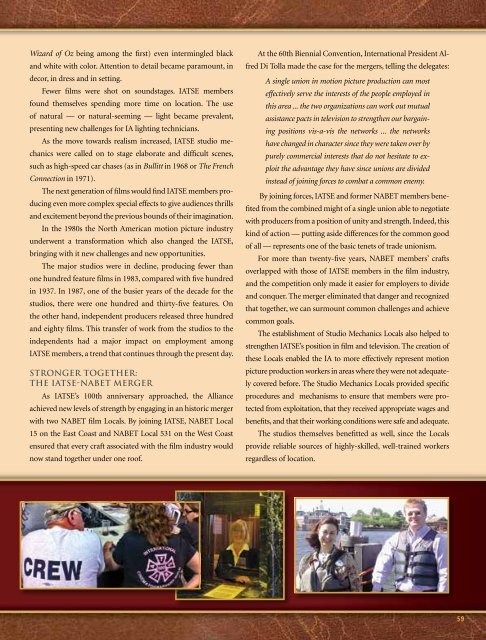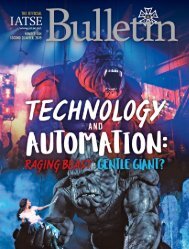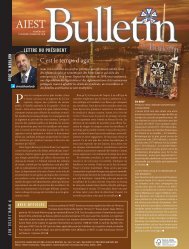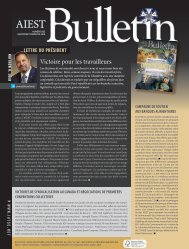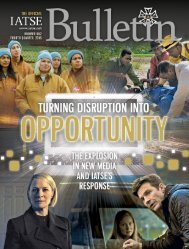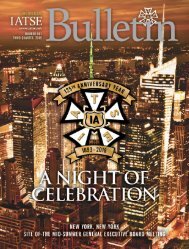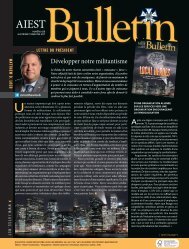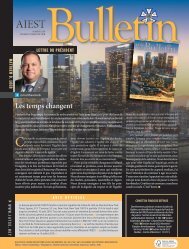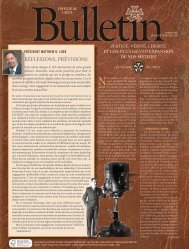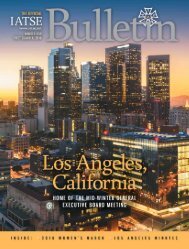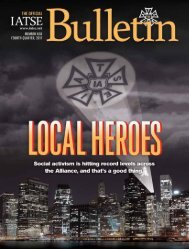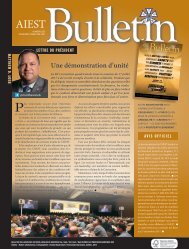IATSE-2nd2018_web
You also want an ePaper? Increase the reach of your titles
YUMPU automatically turns print PDFs into web optimized ePapers that Google loves.
Wizard of Oz being among the first) even intermingled black<br />
and white with color. Attention to detail became paramount, in<br />
decor, in dress and in setting.<br />
Fewer films were shot on soundstages. <strong>IATSE</strong> members<br />
found themselves spending more time on location. The use<br />
of natural — or natural-seeming — light became prevalent,<br />
presenting new challenges for IA lighting technicians.<br />
As the move towards realism increased, <strong>IATSE</strong> studio mechanics<br />
were called on to stage elaborate and difficult scenes,<br />
such as high-speed car chases (as in Bullitt in 1968 or The French<br />
Connection in 1971).<br />
The next generation of films would find <strong>IATSE</strong> members producing<br />
even more complex special effects to give audiences thrills<br />
and excitement beyond the previous bounds of their imagination.<br />
In the 1980s the North American motion picture industry<br />
underwent a transformation which also changed the <strong>IATSE</strong>,<br />
bringing with it new challenges and new opportunities.<br />
The major studios were in decline, producing fewer than<br />
one hundred feature films in 1983, compared with five hundred<br />
in 1937. In 1987, one of the busier years of the decade for the<br />
studios, there were one hundred and thirty-five features. On<br />
the other hand, independent producers released three hundred<br />
and eighty films. This transfer of work from the studios to the<br />
independents had a major impact on employment among<br />
<strong>IATSE</strong> members, a trend that continues through the present day.<br />
STRONGER TOGETHER:<br />
THE <strong>IATSE</strong>-NABET MERGER<br />
As <strong>IATSE</strong>’s 100th anniversary approached, the Alliance<br />
achieved new levels of strength by engaging in an historic merger<br />
with two NABET film Locals. By joining <strong>IATSE</strong>, NABET Local<br />
15 on the East Coast and NABET Local 531 on the West Coast<br />
ensured that every craft associated with the film industry would<br />
now stand together under one roof.<br />
At the 60th Biennial Convention, International President Alfred<br />
Di Tolla made the case for the mergers, telling the delegates:<br />
A single union in motion picture production can most<br />
effectively serve the interests of the people employed in<br />
this area ... the two organizations can work out mutual<br />
assistance pacts in television to strengthen our bargaining<br />
positions vis-a-vis the networks ... the networks<br />
have changed in character since they were taken over by<br />
purely commercial interests that do not hesitate to exploit<br />
the advantage they have since unions are divided<br />
instead of joining forces to combat a common enemy.<br />
By joining forces, <strong>IATSE</strong> and former NABET members benefited<br />
from the combined might of a single union able to negotiate<br />
with producers from a position of unity and strength. Indeed, this<br />
kind of action — putting aside differences for the common good<br />
of all — represents one of the basic tenets of trade unionism.<br />
For more than twenty-five years, NABET members’ crafts<br />
overlapped with those of <strong>IATSE</strong> members in the film industry,<br />
and the competition only made it easier for employers to divide<br />
and conquer. The merger eliminated that danger and recognized<br />
that together, we can surmount common challenges and achieve<br />
common goals.<br />
The establishment of Studio Mechanics Locals also helped to<br />
strengthen <strong>IATSE</strong>’s position in film and television. The creation of<br />
these Locals enabled the IA to more effectively represent motion<br />
picture production workers in areas where they were not adequately<br />
covered before. The Studio Mechanics Locals provided specific<br />
procedures and mechanisms to ensure that members were protected<br />
from exploitation, that they received appropriate wages and<br />
benefits, and that their working conditions were safe and adequate.<br />
The studios themselves benefitted as well, since the Locals<br />
provide reliable sources of highly -skilled, well-trained workers<br />
regardless of location.<br />
59


